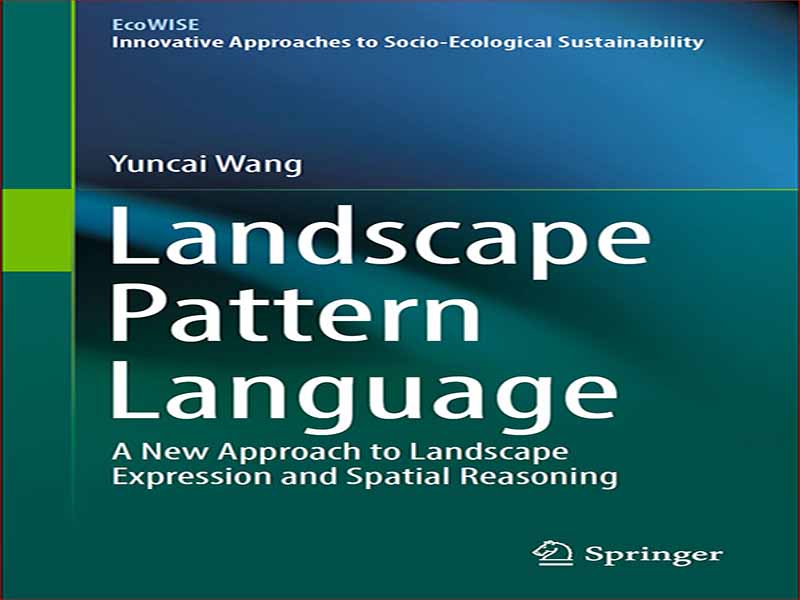- عنوان کتاب: Landscape Pattern Language
- نویسنده: Yuncai Wang
- حوزه: زیست محیطی
- سال انتشار: 2022
- تعداد صفحه: 447
- زبان اصلی: انگلیسی
- نوع فایل: pdf
- حجم فایل: 21.4 مگابایت
بوم شناسی و زندگی و فرهنگ و هنر از ویژگی های اصلی منظر با پیکربندی و عملکرد در مقیاس های متعدد هستند. پس از بیش از صد سال توسعه در معماری منظر مدرن، به وضوح دریافتیم که معماری منظر، رشته شکلدهی زمین با ترکیب علم، هنر و مهندسی با ویژگیهای اساسی وابستگی به بافت، تنوع فضایی و انسان محوری
توسعه پایدار سیستم اجتماعی-اکولوژیکی متشکل از فضای منظر به کانون توجه معماری منظر تبدیل شده است که از خرد اکولوژیکی الهام گرفته و هدایت شده است. بسیاری از نظریه ها و روش های معماری منظر به ویژه با تأکید بر ویژگی اکولوژیکی منظر، مانند فناوری ارزیابی تطبیقی، نظریه انطباق فرهنگی، شهرسازی منظر، زیرساخت سبز، طراحی جغرافیایی، زبان الگو و زبان منظر، به طور متوالی پدید آمده اند. و در زمینه برنامه ریزی، طراحی، نگهداری و مدیریت منظر گام بزرگی به جلو برداشت و ترکیب و مکانیسم منظر، خدمات و عملکرد منظر، ساخت و نگهداری منظر همواره از زمینه های کلیدی تحقیق عملی بوده است.
این انتخابی بود که 20 سال پیش انجام شد و من را تشویق کرد که از جغرافیای انسانی وارد رشته معماری منظره شوم که با تئوری ها و روش های علمی جغرافیا با تمرکز بر رابطه بین انسان و طبیعت و آموزش تحقیقات علمی دریافت شده در آکادمی علوم چین. در دهه اول از طریق تحقیقات در فرآیند اکولوژیکی و الگوی منظر به کاربرد بومشناسی منظر در برنامهریزی و طراحی منظر متعهد شدم و شروع به ایجاد چارچوب و رویکردهای برنامهریزی و طراحی منظر بهویژه تحت حمایت بودجه ملی طبیعت کردم. بنیاد علمی چین
کتابها و مقالههای زیادی در مورد برنامهریزی اکولوژیکی منظر در طول دوره منتشر شد، مانند اصول برنامهریزی اکولوژیکی منظر (نسخه اول، 2007؛ ویرایش دوم، 2013؛ ویرایش سوم، 2022) به عنوان کتاب درسی برنامهریزی ملی پنج ساله دوازدهم چین. ، بررسی موارد برنامه ریزی و طراحی اکولوژیک منظر (ویرایش اول، 2013) و ترجمه کتاب برنامه ریزی اکولوژیکی: ترکیب تاریخی و مقایسه ای (فورستر ندوبیسی، چاپ چینی، 2013).
مجموعه کتابهای درسی و تکنگاری شامل تئوریهای طراحی و طراحی اکولوژیکی منظر، روشها، تاریخچه و موارد کلاسیک با تلاش ما ایجاد شده است که برای من یک پروژه دانشگاهی بزرگ است و مشارکتهای پژوهشی جوایز متعددی را برای The کتاب های درسی برنامه ریزی ملی، کتاب های درسی عالی برای دانشگاه ها در شانگهای، و کتاب های درسی عالی دانشگاه تونگجی. با این حال، همیشه فکر میکردم که این دستاوردها در مسیر سنتی برنامهریزی و طراحی اکولوژیک منظر در زمینه معماری منظر حاصل شده و همچنین انباشت اولیه و اولین قدم راه آکادمیک شخصی من است.
پس از یک تحقیق طولانی مدت در مورد برنامه ریزی و طراحی معماری منظر و تجربه تدریس و تمرین واقعی برنامه ریزی بوم شناختی، به یک سوال بزرگ پی بردم و متوجه شدم که ممکن است یک رویکرد ممکن برای معماری منظر برای اجرای برنامه ریزی اکولوژیکی و پیاده سازی محیط زیست ایجاد شود. طرح. در دهه دوم، رؤیای نظریه و روش جدید بود که ما را ترغیب به اجرای تحقیقات در زمینه نوآوری کرد. در ابتدا، این تفکر مغشوش بود زیرا مسیرهای سنتی نه می توانستند به طور کامل به این سؤال پاسخ دهند که جوهره فضای اکولوژیکی در معماری منظر چیست و نه به طور کامل و مؤثر مشکلات تمرین در برنامه ریزی و طراحی اکولوژیک منظر را حل کند.
Ecology and life, and culture and art are the main attributes of landscape with configuration and function at multiple scales. After more than one hundred years of development in modern landscape architecture, it was clearly realized that land-scape architecture is the discipline of land shaping by the combination of science, art, and engineering with the essential characteristics of context dependence, spatial variability, and human centricity.
The sustainable development of socio-ecological system composed of landscape space has become the focus of landscape architecture which was inspired and guided by ecological wisdom. Many theories and methods of landscape architecture espe-cially emphasizing the ecological attribute of landscape, such as adaptive evalua-tion technology, cultural adaptation theory, landscape urbanism, green infrastruc-ture, geographic design, pattern language, and landscape language, have emerged successively and made a big step forward in the field of landscape planning, design, maintaining, and management, and the composition and mechanism of landscape, landscape service and performance, and landscape construction and maintenance have always been the key fields of practice research.
It was a choice made 20 years ago that encouraged me step into the field of land-scape architecture from human geography which provided a good foundation for my academic road with the scientific theories and methods of geography focusing on the relationship between man and nature and the scientific research training received at the Chinese Academy of Sciences. In the first decade, I was committed to the appli-cation of landscape ecology in landscape planning and design through the researches in ecological process and landscape pattern and began to establish the framework and approaches to landscape planning and design especially under the funding of National Nature Science Foundation of China.
Lots of books and articles on landscape ecological planning was published openly during the period, such as Principles of Landscape Ecological Planning (First edition, 2007; Second Edition, 2013; Third edition, 2022) as the Twelfth Five-Year National Planning Textbook of China, Reviews on Landscape Ecological Planning and Design cases (First edition, 2013) and translated the book Ecological Planning: A Historical and Comparative Synthesis (Forster Ndubisi, Chinese edition, 2013).
The series of textbooks and monographs including landscape ecological plan-ning and design theories, methods, history, and classic cases has been established through our hard working, which is a huge academic project for me, and the research contributions had won several awards for The National Planning Textbooks, The Excellent Textbooks for Universities in Shanghai, and The Excellent Textbooks of Tongji University. However, I always thought that these achievements were made on the traditional path of landscape ecological planning and design in the field of landscape architecture and are also the primary accumulation and the first step of my personal academic road.
After a long-term research on planning and design of landscape architecture and the teaching experience and real practice of ecological planning, I found a big ques-tion and noticed that a possible approach might be constructed for landscape archi-tecture to implement ecological planning and design. In the second decade, it was the dream of new theory and method that encouraged us to implement the researches on the innovative field. At the beginning, this thinking was confused because the traditional paths could neither fully answer the question of what is the essence of ecological space in landscape architecture nor completely and effectively solve the problems of practice in landscape ecological planning and design.
این کتاب را میتوانید بصورت رایگان از لینک زیر دانلود نمایید.
Download: Landscape Pattern Language



































نظرات کاربران